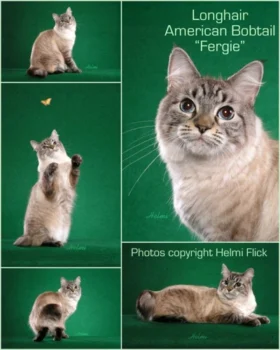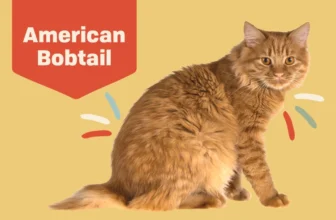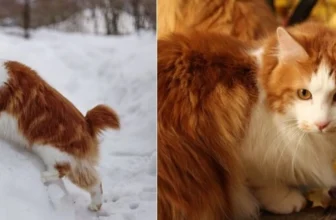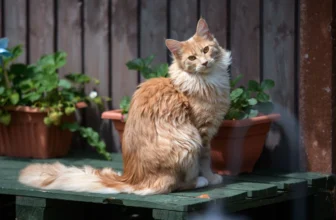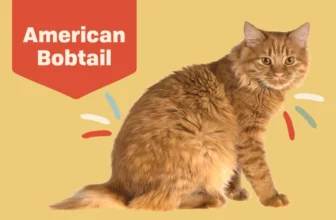As a proud owner of an American Bobtail, you may have noticed that your feline friend has a unique way of communicating with you. While they may not speak in words, their body language reveals a lot about their emotions, feelings, and relationship with you. Understanding your American Bobtail’s body language is crucial to building a strong bond with them. In this article, we will explore the different body language signs that your American Bobtail uses to show affection, stress, and bonding. We will also provide tips on how to strengthen your bond with your furry friend. So, grab a cup of coffee, snuggle up with your American Bobtail, and let’s unravel the mystery behind their body language!
Body Language Signs of Affection and Trust

Our furry friends have numerous ways of expressing themselves, and body language is one of the most important communication tools they possess. As a cat owner, it’s important to understand the subtleties of your American Bobtail’s body language in order to strengthen your bond and deepen your connection. In this section, we will explore some of the most common body language signs of affection and trust so that you can better understand what your feline companion is trying to tell you. By recognizing and responding to these signals, you can create a stronger, more meaningful relationship with your American Bobtail. To learn more about the importance of bonding with your cat, check out our article on the benefits of bonding with your American Bobtail.
Purring
The sound of a contented purrrrr from your American Bobtail is one of the most telltale signs of their happiness and affection towards you. When your fluffy feline makes this soothing sound, it means that they are relaxed, comfortable, and happy. Purrs often occur while your bobtail is sitting on your lap, getting petted or when they are relaxed.
According to studies, cats’ purr releases endorphins that help them feel calm and relaxed. It’s the same hormone that makes us feel happy and lessens stress. When a cat purrs near you, it’s a sign that they trust you and feel safe in your presence.
But keep in mind that not all purrs signal contentment. Sometimes out of pain, illness, or stress, cats produce a different type of purr, lower in pitch and volume of breath. This purr is called the “solicitation purr.” If you observe this type of purring, check in with your veterinarian for potential health concerns.
Here are some additional ways to interpret the sound of a purring American Bobtail:
| Loud and Clear | Your American Bobtail is excited and highly content. |
| Low and Slow | Your American Bobtail is ready to nap or wants a more relaxed petting session. |
| Short and Quick | Your American Bobtail is happy to see you but is too excited to sit still for too long. |
When your American Bobtail purrs near you, it’s a sign that they feel content, relaxed and trustful in your company. If you want to build your bond and trust with your cat, engage in some quality bonding activities that they love. These include activity games, interactive toys, and cuddle sessions. For more ideas on how to bond with your cat, check out our post on 10 bonding activities with your American Bobtail.
Slow Blinks
Slow blinks are one of the most common ways your American Bobtail communicates their affection towards you. When your feline companion looks at you and slowly blinks, it’s their way of saying “I trust you”. Slow blinks are also known as “cat kisses”. This slow blink signal is a way for cats to convey a sense of relaxation and affection. If you want to establish a strong bond with your American Bobtail, learning how to interpret their slow blinks is key.
Sometimes, this slow blinking will even turn into a reciprocal exchange between you and your fur baby. To show your cat that you trust them back, you can try returning the slow blink. When your cat sees you reciprocating this body language, they will take it as a sign that you love and trust them too. It’s essential to understand that a slow, relaxed blink from your cat is a clear indication that they feel comfortable and at ease around you.
If you’re not sure whether your cat is blinking slowly or just sleepy, you can observe their other body language cues. A cat that’s feeling relaxed and affectionate will often have their ears positioned forward, their tail held loosely, and may even be purring. On the other hand, if your cat is stressed or anxious, they may have dilated pupils, flattened ears, or even their fur may be standing on end. By paying attention to your American Bobtail’s body language and subtle cues, you can learn to understand their emotions and establish trust and affection with them.
To develop a strong bond with your American Bobtail, you should create a safe and comfortable environment for them. Provide your cat with the right food, toys, and bedding. Additionally, make sure to spend quality time with your pet, by engaging in activities such as playtime or grooming. When you’re consistent in your interactions with your furry friend, you’ll become more attuned to their body language and emotions. By doing this, you can enjoy the benefits of bonding with your American Bobtail, which include less stress, improved health, and a more fulfilling relationship between pet and owner. If you want more tips on establishing trust with your American Bobtail, check out our article on how to establish trust with your American Bobtail. Or learn about the benefits of bonding with American Bobtails.
Curled Tail
When your American Bobtail curls their tail, it can indicate a variety of emotions and moods. It’s important to pay attention to other body language cues to decipher what they may be trying to communicate.
Signs of Affection: A loosely curled tail held in a relaxed manner can be a sign that your Bobtail is feeling content and comfortable. This may be accompanied by purring or slow blinks, indicating trust and affection towards you.
Signs of Stress: If your Bobtail’s tail is tightly curled and held close to their body, this may indicate fear or anxiety. You may also see other signs of stress such as flattened ears or dilated pupils.
Signs of Alertness: When your Bobtail is on high alert, their tail may be tightly curled but held high in the air. This can indicate curiosity or a perceived threat in their environment.
Signs of Aggression: A quivering or thrashing tail can be a sign of aggression in your Bobtail. This may be accompanied by other aggressive body language such as hissing or growling.
It’s important to pay attention to your Bobtail’s overall body language and take into account their personality and past experiences when interpreting their curled tail. Creating a bond with your Bobtail takes time and patience, but understanding their body language can be a valuable tool in strengthening your relationship.
| Signs of Affection | Signs of Stress | Signs of Alertness | Signs of Aggression |
|---|---|---|---|
| Loosely curled tail | Tightly curled tail held close to body | Tightly curled tail held high in the air | Quivering or thrashing tail |
| Relaxed manner | May be accompanied by flattened ears or dilated pupils | May be accompanied by other signs of curiosity or threat | May be accompanied by hissing or growling |
Relaxed Body Posture
Cats have a unique way of using their body language to convey their emotions and thoughts. A relaxed body posture in American Bobtails is a clear sign that they trust and feel safe in your presence. When your American Bobtail is relaxed, they will lay on their side with their head facing upwards or sit with their tail curled around them.
Signs of a Relaxed Body Posture:
| Position: | Lying on their side or sitting with tail curled around them |
| Ears: | In a neutral or slightly forward position |
| Eyes: | Open and relaxed |
| Tail: | Slightly curved or wrapped around the body |
| Muscles: | Relaxed |
In this relaxed state, their muscles aren’t tense, and their ears are positioned neutrally or slightly forward. Their eyes will be open, and they will be looking at you calmly. The tail will be slightly curved or wrapped around the body, indicating a sense of security. Your American Bobtail’s body will be at ease without showing any indications of tension.
It’s vital to understand this body language sign as it’s a clear indication that your American Bobtail is happy and at ease in your presence. Whenever you see these relaxed signs, it’s advisable to take note of what’s happening in the environment and replicate it to help your furry friend relax.
Body Language Signs of Stress and Anxiety
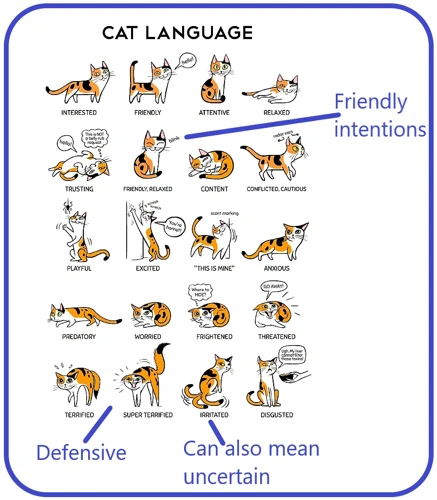
Just like humans, American Bobtails can experience stress and anxiety. As their caretaker, it’s important to understand the various body language signs that may indicate they are feeling overwhelmed. By being able to recognize these signs, you can take steps to alleviate their stress and help them feel more comfortable in their environment. Keep an eye out for the following body language cues that may suggest your American Bobtail is experiencing stress or anxiety.
Dilated Pupils
When your American Bobtail is feeling stressed or anxious, one of the signs you might notice is dilated pupils. The eyes of your cat can offer an insight into their emotional state, and dilated pupils are a clear sign that something isn’t right.
| What are dilated pupils? |
|---|
| Dilated pupils are pupils that are larger than normal. Instead of being a slit, your cat’s pupils will be much wider and more open. This is because the iris muscle has relaxed, allowing more light in. |
| What do dilated pupils indicate? |
| Dilated pupils are not always a sign of stress or anxiety – they can also indicate excitement or pleasure. However, when accompanied by other signs such as flattened ears, a tense body posture or hissing, dilated pupils can be indicative of your cat feeling uneasy. |
| What should you do if you notice dilated pupils? |
| If you notice dilated pupils in your American Bobtail, try to determine what might be causing their anxiety or stress. Consider their surroundings, whether there are any loud noises or new objects in the environment, or if they are feeling threatened in any way. Try to provide a safe and quiet space for your cat to relax and destress. |
It’s important to remember that every cat is unique, and signs of anxiety or stress can vary from cat to cat. If you’re ever unsure of your cat’s behaviour, it’s always best to consult with your vet or a certified cat behaviourist to make sure your feline friend is happy and healthy.
Flattened Ears
When a cat’s ears are flattened, it is a sign of stress or fear. However, in some cases, it may also indicate aggression. If your American Bobtail is displaying flattened ears, it is important to analyze the situation and try to identify the cause of their discomfort.
Possible Reasons for Flattened Ears
| Reasons | Explanation |
|---|---|
| Pain or discomfort | American Bobtails tend to hide their pain, so flattened ears may be the only physical sign of their discomfort. |
| Overstimulation | Cats can become overwhelmed with too much petting or attention, which can cause them to feel stressed or anxious. |
| Environmental factors | Changes in the environment, such as the presence of a new pet or unfamiliar visitors, can cause a cat to feel threatened and display flattened ears. |
| Aggression | In some cases, flattened ears may indicate that the cat is feeling aggressive and ready to defend itself. |
What to Do
If your American Bobtail is displaying flattened ears, it is important to approach them with caution. A cat with flattened ears may be feeling stressed, anxious, or aggressive, so it is important to avoid any sudden movements that may startle them.
Try to identify the cause of your cat’s discomfort and remove any stressors from their environment. Providing a safe and comfortable space for your cat to retreat to can also help them feel more secure.
If you suspect that your cat is in pain or discomfort, it is important to take them to the veterinarian for a check-up. In some cases, a cat may require medication or treatment to manage their pain.
Consistency and patience are key when it comes to strengthening your bond with your American Bobtail. By paying attention to their body language and providing a safe and comfortable environment, you can help them feel more secure and strengthen your bond over time.
Flicking Tail
The American Bobtail’s tail is one of their most expressive body parts, and it can reveal a lot about their mood and feelings. When an American Bobtail is feeling agitated, anxious or nervous, they will often flick their tail in a rapid, back-and-forth motion. Although this action may seem harmless, it is actually a clear indication that your cat is feeling distressed.
So why do American Bobtails flick their tails when they’re anxious?
There are a few different explanations for this behavior. One theory is that the flicking tail is a leftover instinct from their wildcat ancestors. In the wild, cats would use their tails to provoke and intimidate their prey, so it’s possible that some of these instincts have carried over. Alternatively, your American Bobtail may be flicking their tail as a way to release excess energy or to cope with stress.
What should you do if your American Bobtail is flicking their tail?
If you notice your American Bobtail flicking their tail, it’s important to pay attention to their other body language cues. Are their ears flattened? Are their pupils dilated? If so, your cat may be feeling extremely stressed or agitated. In this case, it’s best to give your cat some space and allow them to calm down on their own. If you try to interact with them while they’re flicking their tail, it could make the situation worse.
How can you prevent your American Bobtail from flicking their tail?
If your American Bobtail is prone to flicking their tail when they’re feeling anxious, there are a few things you can do to help prevent the behavior. First, make sure your cat has plenty of toys and ways to play and release energy. This can include climbing towers, scratching posts, and interactive toys that encourage exercise and movement. Additionally, try to create a calm and predictable environment for your cat. This can involve establishing a regular feeding schedule, keeping their litterbox clean, and providing them with a comfortable and secure sleeping space.
Flicking tail is a common body language sign of anxiety and stress in American Bobtails. Understanding their needs and providing a safe, comfortable environment is key to preventing this behavior and building a strong bond with your feline friend.
Arching Back
One of the body language signs that suggest your American Bobtail is experiencing stress or anxiety is the arching back. When your cat arches its back, it may indicate an attempt to make itself look bigger and more intimidating. However, it can also suggest that your cat is feeling threatened or uncomfortable.
Here are some possible reasons why your American Bobtail may arch their back:
- They feel scared or threatened by something or someone in their environment, such as a loud noise, a new person, or a new animal.
- They are anticipating a possible threat, and they want to be ready to defend themselves
- They are feeling defensive or aggressive, and they want to communicate this to others
- They are in pain or discomfort
As an owner, it’s essential to observe your cat’s body language carefully and determine the reason behind the behavior. If your American Bobtail is arching its back, try to provide a safe and quiet environment for them to calm down. Reduce any possible sources of stress or discomfort, such as loud music or other animals.
In some cases, arching the back may be a part of a more complex body language pattern, such as hissing, puffing up the fur, or flattening the ears. Stay alert and pay attention to all these signs to understand your pet’s emotions better.
Remember that any sudden changes in behavior can be a sign of an underlying health issue, so if the arching of the back becomes a frequent occurrence, consider scheduling a consultation with your veterinarian to rule out any health conditions.
If your American Bobtail arches its back, don’t ignore it. Instead, pay attention to all the other body language signs and make sure your cat feels comfortable and safe in their environment to reduce their stress levels.
Body Language Signs of Love and Bonding
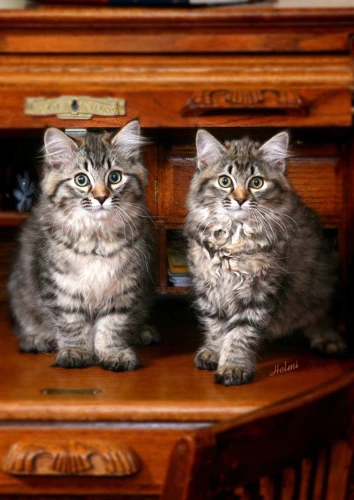
As your American Bobtail becomes more comfortable with you, they may start to show signs of love and bonding through their body language. It’s important to pay attention to these behaviors, as they indicate a strong connection between you and your furry companion. Here are some key physical cues that your cat is feeling loving and bonded with you.
Head Bumping
When your American Bobtail head bumps you, it’s a clear sign of affection and trust. This action is a way of marking you as a friend and also shows their desire for attention. It’s an endearing gesture that’s indicative of a strong bond between you and your furry friend. So, what does head bumping look like and how should you respond?
What is Head Bumping?
Head bumping is when your American Bobtail gently touches its head against your body or face. It is often repeated several times to express the cat’s joy and happiness. Some cats may even rub their scent glands located on their cheeks against you during the head bump, leaving a mark as a way of claiming you as their own.
Why Do They Do It?
Head bumping is a way for cats to show their affection and trust towards you. It’s their own way of saying “hello” and “I love you”. By doing this, they mark you with their scent and establish a bond, creating a sense of familiarity and comfort between you and your American Bobtail.
How Should You Respond?
When your American Bobtail head bumps you, it’s important to respond with positive reinforcement. This can include gentle petting or simply saying their name in an affectionate tone. It’s important to avoid sudden movements or loud noises that may startle your cat and interrupt the bonding moment. Instead, show your furry friend love and affection in return.
Conclusion
Head bumping is a clear indication that your American Bobtail trusts and loves you. It’s important to respond positively and reinforce this bond by showing them love and affection in return. By doing so, you will not only strengthen your relationship with your feline friend but also create a lasting bond that will continue to grow over time.
Tail Twitching in Contentment
When your American Bobtail twitches its tail in contentment, it is a sign that they are happy and relaxed in your company. This behavior is often accompanied by purring and a calm body posture. Understanding this subtle body language can help you build a stronger bond with your furry companion.
Here are some additional details about tail twitching in contentment:
| Tail Position | Meaning |
|---|---|
| Slow, gentle twitching | Your American Bobtail is content and relaxed |
| Tail held low and twitching | Your American Bobtail is feeling playful and happy |
| Rapid or aggressive tail twitching | Your American Bobtail may be feeling anxious or agitated |
It is important to pay attention to the speed and intensity of your American Bobtail’s tail twitching, as this can indicate their emotional state. Slow and gentle tail twitching is a positive sign, while rapid or aggressive twitching may indicate stress or anxiety.
If your American Bobtail is twitching its tail in contentment, it is a good opportunity to spend some quality time with them. Play a game, offer a tasty treat, or simply give them some cuddles and attention. This will strengthen your bond and help your cat feel even more relaxed and happy in your company.
Remember, every cat is unique, and their body language can sometimes be complex and difficult to interpret. By paying close attention to your American Bobtail’s tail twitching and other body language cues, you can deepen your understanding of their emotional world and build a stronger bond with them.
Sleeping with You
One of the ultimate signs of trust and affection that an American Bobtail can show you is sleeping with you. Sharing a bed with your feline friend is an intimate experience that speaks volumes about the bond you share. If your American Bobtail chooses to sleep with you, it shows that they trust you completely, and feel safe and secure in your presence.
When your American Bobtail snuggles up with you at night, it’s a clear indication that they love and value your company. This is a powerful expression of trust, and it’s crucial to make sure that you reciprocate this trust by providing a comfortable and safe sleeping environment for your furry friend.
Here are some things to keep in mind if you’re thinking about sleeping with your American Bobtail:
- Provide a comfortable sleeping space: Make sure that your bed is big enough to accommodate both you and your cat comfortably, and that there’s plenty of space for them to move around if they need to.
- Be mindful of their sleep habits: Cats are nocturnal creatures, so they may be more active at night. If your American Bobtail likes to play or explore during the night, make sure that they have plenty of toys and stimulation to keep them occupied.
- Avoid disturbing them: Once your American Bobtail has settled down to sleep, try not to disturb them. Cats need plenty of uninterrupted rest, and they may become unsettled or agitated if they’re disturbed while they’re sleeping.
- Take care of your own sleep needs: Finally, remember that your own sleep needs are just as important as your cat’s. If you find that your American Bobtail is disrupting your sleep or making it difficult for you to get a good night’s rest, it may be best to provide them with their own sleeping space.
Sleeping with your American Bobtail can be a wonderful bonding experience that strengthens your relationship and reinforces the trust that you share. By being mindful of your cat’s needs and providing a safe and comfortable sleeping environment, you can enjoy this intimate experience and cherish the special bond that you share with your feline friend.
Greeting You at the Door
When your American Bobtail greets you at the door, it’s a sure sign of their love and attachment to you. They may run to the door, meow loudly, or rub against your legs to welcome you home. This behavior reinforces the bond between the two of you and shows that they have missed you.
Here are some reasons why your American Bobtail greets you at the door:
- They missed you: American Bobtails are social creatures who crave companionship. When you leave them alone, they may feel lonely and miss your company. So, when they see you coming home, they get excited and greet you enthusiastically.
- They want attention: Your American Bobtail may greet you at the door because they want your attention. They may meow, rub against your legs, or sit in front of you to get petted. This behavior shows that they value your interaction and want to spend time with you.
- They want to mark their territory: American Bobtails, like many other cats, are territorial animals. They have a strong sense of ownership, and your home is their territory. By rubbing their scent on you, they are marking you as belonging to them and reinforcing their ownership.
- They want to show their love: When your American Bobtail greets you at the door, they are expressing their love and attachment to you. They are happy to see you and want to spend time with you because they enjoy your company.
What can you do to strengthen the bond with your American Bobtail?
- Give them attention: When your cat greets you at the door, give them some love and attention. Pet them, play with them, or simply talk to them. This will help them feel valued and strengthen your bond.
- Play with them: American Bobtails are energetic cats who love to play. Spend some time playing with them, and they will be more attached to you. Playtime also helps them release pent-up energy and reduce stress.
- Use positive reinforcement: Reward your cat for good behavior, such as greeting you at the door or cuddling with you. This will reinforce their positive behavior and make them more likely to repeat it.
- Respect their boundaries: While affection is important, it’s also important to respect your cat’s boundaries. If they don’t want to be petted or played with, give them space. This will help them feel more comfortable around you and strengthen your bond in the long run.
What to Do to Strengthen Your Bond with Your American Bobtail
As much as your American Bobtail’s body language can reveal their level of trust and love for you, it takes effort on your part to strengthen the bond between you and your feline friend. Whether you’re a new owner or a longtime parent to an American Bobtail, there are several things you can do to create a strong, loving relationship with your furry companion. Here are some tips to help you build and maintain a healthy and happy bond with your American Bobtail.
Pay Attention to Their Comfort
As a pet parent, it’s crucial to pay attention to your American Bobtail’s comfort. After all, they rely on you for their well-being, and showing that you care will only strengthen your bond. Here are some ways to ensure that your feline friend is comfortable:
- Provide a Comfortable Environment: Make sure your American Bobtail has a cozy bed to sleep on, and that their litter box and food and water dishes are easily accessible.
- Ensure They Feel Safe: Avoid making sudden loud noises or movements that could spook your cat. Providing hiding spots, such as a covered bed or hiding box, can also help them feel more secure.
- Regular Vet Visits: Take your American Bobtail to the vet regularly for check-ups and vaccinations. This will help keep them healthy and comfortable in their own skin.
- Keep Them Groomed: Regular brushing and nail trimming can help your cat feel comfortable in their own fur. It also gives you a chance to bond with them through grooming.
- Pay Attention to Their Body Language: When your American Bobtail is uncomfortable or stressed, they may exhibit body language such as flattened ears or a flicking tail. If you notice these signs, try to identify the cause and alleviate it as soon as possible.
By taking these steps to ensure your American Bobtail’s comfort, you are showing them that they can trust you to provide for their needs. This will help build a strong bond between you and your furry companion.
Consistency is Key
One of the most important things you can do to strengthen your bond with your American Bobtail is to be consistent in your behavior with them. Cats are creatures of habit and thrive on routine, so it’s important to maintain a consistent schedule when feeding, playing, and spending time with your cat.
One way to do this is by creating a daily routine for your cat that includes regular playtime, feeding times, and quiet time for relaxation. By doing so, your cat will become more comfortable and feel more secure in their environment.
Additionally, consistency in your behavior towards your cat is important for building trust and strengthening your bond. It’s important to always be patient and understanding with your cat, even if they have occasional misbehaviors. Using positive reinforcement techniques, such as treats and praise, also help in building a stronger bond with your cat.
To help you maintain consistency, consider creating a schedule or using a planner to keep track of your cat’s daily routine, and be sure to stick to it as closely as possible. Another helpful tip is to create a special routine for bonding time between you and your cat. Whether it’s playing with their favorite toy or snuggling up together for a nap, having a consistent bonding routine can greatly improve trust and communication between you and your cat.
Remember, consistency is key when it comes to building strong bonds with your American Bobtail. By providing them with a consistent routine and behavior, you’ll be able to establish a deep and trusting relationship with your furry best friend.
| Consistency provides: | Security | Comfort | Trust |
| How to maintain consistency: | Create a daily routine | Be patient and understanding | Use positive reinforcement |
| Benefits of consistency: | Improved communication | Established bonds | Increase in trust |
Play and Stay Active Together
One of the best ways to bond with your American Bobtail is by engaging in playtime and physical activity together. This not only helps to establish trust and affection between you and your furry companion, but it also promotes a healthy and happy lifestyle for them.
Try these fun ideas:
- Interactive toys: American Bobtails are highly intelligent and love interactive toys that encourage them to use their problem-solving skills. Puzzle feeders, feather wands, and laser pointers are great options that will keep your feline friend engaged and active.
- Obstacle courses: Set up an obstacle course for your American Bobtail using simple household items such as cardboard boxes, tunnels, and furniture. This will challenge their agility and keep them entertained for hours.
- Outdoor adventures: American Bobtails love exploring and experiencing the great outdoors. Take your cat for a leash walk or play fetch with them in a secure outdoor area. Make sure to supervise them at all times and use a harness designed for cats to safely enjoy the outdoors.
Remember to:
- Start slowly and gradually increase the intensity and duration of playtime.
- Use positive reinforcement and treats to reward good behavior.
- Rotate your cat’s toys to keep them interested and engaged.
- Take breaks when your cat appears to be tired or overstimulated.
By playing and staying active together, you’ll not only strengthen your bond with your American Bobtail but also help them maintain physical and mental wellbeing.
Quality Time
Spending quality time with your American Bobtail can greatly strengthen your bond with them. This means setting aside dedicated time each day to engage with your cat in activities that they enjoy. Whether it’s playing with their favorite toys, grooming them, or simply cuddling together, this focused attention will show your cat that you value their company and care about their happiness.
To make the most of your quality time together, consider creating a schedule or routine that works for both you and your cat. This will help establish a sense of predictability and security for your pet, which is especially important for cats who may be more sensitive or anxious.
You can also use this time to teach your cat new tricks or behaviors. Positive reinforcement training is a great way to build your cat’s confidence and improve their obedience. This can also be a fun bonding activity for you both.
Here are some ideas for quality time activities with your American Bobtail:
| Activity | Description |
|---|---|
| Interactive Playtime | Use toys like laser pointers, wand toys, or feather toys to engage your cat in active play. This can help them burn off energy and feel more relaxed. |
| Grooming Sessions | Regular brushing, nail clipping, and ear cleaning can help keep your cat healthy and comfortable. It’s also a great opportunity to bond and show affection. |
| Cat TV | Set up a bird feeder or offer a window perch to provide entertainment for your cat. Watching the birds or squirrels can be a fun and engaging activity for them. |
| Quiet Time | Take some time each day to simply sit with your cat and offer them attention and affection. This can help them feel valued and loved. |
Remember, the key to building a strong bond with your American Bobtail is to be patient, consistent, and attuned to their needs. By showing them love, attention, and respect, you can enjoy a lifelong friendship with these amazing and affectionate cats.
Conclusion
In conclusion, understanding your American Bobtail’s body language can greatly improve your bond with them. By recognizing signs of affection and trust, stress and anxiety, and love and bonding, you can better communicate with your feline friend and create a strong relationship based on trust and mutual understanding.
Remember to pay attention to your American Bobtail’s comfort and needs, consistency is key in your interactions with them. Playing and staying active together and dedicating quality time for them can also help reinforce your bond.
Don’t forget that every cat is an individual, and they may display their body language differently. Be patient and observant, and you will eventually find what works best for you and your American Bobtail.
In the end, your American Bobtail’s body language is a way of communicating with you. By paying attention to what they’re saying, you open up a world of possibilities for a happy and fulfilling relationship with your feline companion. So go ahead, build that bond, and enjoy the company of your American Bobtail.
Frequently Asked Questions
What are some common body language signs of affection in American Bobtails?
Some common signs of affection include purring, slow blinks, curled tail, and relaxed body posture.
What are some signs of stress and anxiety in American Bobtails?
Some signs of stress and anxiety include dilated pupils, flattened ears, flicking tail, and arching back.
What are some signs of love and bonding in American Bobtails?
Some signs of love and bonding include head bumping, tail twitching in contentment, sleeping with you, and greeting you at the door.
How can I strengthen my bond with my American Bobtail?
You can strengthen your bond by paying attention to their comfort, being consistent, playing and staying active together, and spending quality time together.
What should I do if my American Bobtail is showing signs of stress?
If your cat is showing signs of stress, try to remove the source of stress and provide a comforting environment. If the stress persists, consider consulting with a veterinarian.
How important is it to understand my American Bobtail’s body language?
Understanding your cat’s body language is important for building a strong bond and preventing misunderstandings or conflicts.
Can body language tell me if my Bobtail is in pain?
While body language can give some indication of pain or discomfort, it’s important to remember that cats are masters at hiding pain. Always consult with a veterinarian if you suspect your cat may be in pain.
Is it safe to approach my American Bobtail when their tail is flicking?
A flicking tail can be a sign of agitation, so it’s important to approach your cat with caution and be aware of their signals.
How long does it take to build a strong bond with an American Bobtail?
The time it takes to build a strong bond varies for each cat and owner, but consistency and patience are key in building a lasting bond.
Can training improve my American Bobtail’s body language communication?
Yes, training can improve your cat’s communication skills and strengthen the bond between you and your pet.

